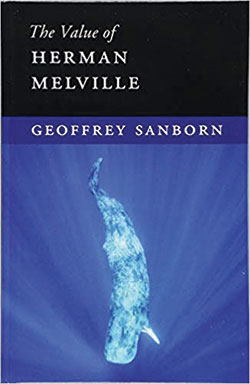
The Value of Herman Melville does precisely that, which testifies to Sanborn’s kinetic thinking and profound yet conversational voice.

That’s the kind of pragmatic existential wisdom that perked the hearts of just about everyone in the seminar Sanborn taught when I was a sophomore. It’s in radiant form here.
The Value of Herman Melville is not a humorless biographical tour. Rather, Sanborn offers 12 quickly paced yet richly researched chapters that lead us through the experience of reading Melville’s great works, from Moby-Dick to “Bartleby, the Scrivener.” Sanborn explores the ways in which Melville communicates the complexities of being human—and how his words make us feel more truly alive.
Each chapter makes the world shine a bit brighter than before.
Born in 1819 in New York City, Melville became a whaler in 1840. He began writing in relative obscurity after several voyages, and he died in 1891, “almost entirely forgotten by the reading public,” writes Sanborn. His magnum opus, Moby-Dick, was far from canonical. In fact, when first published in 1852, it received scathing reviews.

Sanborn weaves in his personal experience reading and teaching
Melville, giving the book the intimacy of a memoir. He takes a
similar approach in his classes.
That changed with the Melville revival of the mid-20th century when he was recognized as a great American writer. Still, his reputation remained shrouded in “mystified value.” To this day, he is widely considered inaccessible and enigmatic.
Sanborn’s book removes the shroud, offering everyone from the seasoned critic to the first-time reader insight into Melville as brilliant storyteller, philosopher and, yes, friend. At the same time, the book offers an introduction to textually engaged literary analysis—specifically, how it helps us to become more astute thinkers. You’d be as happy reading it by a warm fire as in Frost.
But it is not only joy we find in Melville. Sanborn also leads the reader through the painful loneliness that Melville experienced—and that many of his characters, including rage-filled Ahab, confront.
Throughout, Sanborn weaves in his personal experience reading and teaching Melville, giving The Value the intimacy of a memoir. He takes a similar approach in his classes, which invite students to discuss literature and ideas not as abstractions but as potential “accompaniers of one’s life,” in his words. His seminars are as existentially resonant as they are intellectually challenging. It’s not uncommon to overhear a conversation about a recent Sanborn class in the dining hall.
In times short on human decency, Sanborn’s book is a restorative read. But it is not an escape from the world. It is, rather, a voyage through it, with no shortage of intellectual and emotional swells. And with each chapter I finished, I felt the reflective quietude that comes after a long voyage, when you’re bobbing back in the harbor—and the world is shining a bit brighter than before.
Pagano, an English major at Amherst, is a fellow at RALLY, a Los Angeles-based communications firm, as well as a freelance writer.